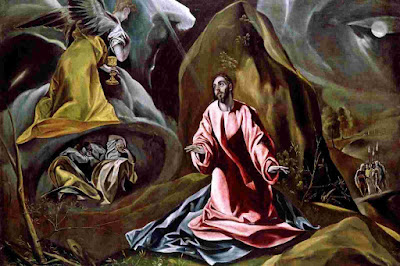leading from
This line starts out from Nativity icon at St Catherine's monastery, which mysteriously appears to reference the Egyptian Henu Barque and loosely echoes the layout of forms to be found at Occator Crater on the Ceres planetoid. But the main feature is Gustave Courbet's "L'Origine Du Monde" that can be seen to reference El Greco's The Agony in the Garden of Gethsemane in a curious way.
Numerous paintings reference the Nativity Icon, numerous paintings reference the El Greco painting.
What appears to reference Courbet's piece are the very famous Basel version of "Isle of the Dead" by Arnold Böcklin which was the first version of five that he did, and it also seems to show signs of El Greco's painting and perhaps the Henu Barque as well, and the piece itself
With that came the realisation that Skat players: Card Playing War Invalids (1920) by Otto Dix referenced the Basel version of Isle of the Dead, perhaps there's an echo of "L'Origine Du Monde" with the left breast becoming the central head.
A couple of days after his passing, a surprise came when I noticed that Alan Bean the former Apollo 12 astronaut's "Our World At My Fingertips" from 2005 conformed to elements of the Courbet painting
7th Century) Nativity icon at St Catherine's monastery
See also: Nativity icon at St Catherine's monastery
| The Nativity icon, St Catherine's Monastery, South Sinai Governorate, Egypt, approximately 7th century AD. |
1590s) The Agony in the Garden of Gethsemane by El Greco
 |
| The Agony in the Garden of Gethsemane by El Greco in 1590s |
1866) L'Origine Du Monde by Gustave Courbet
 |
| Gustave Courbet's L'Origine Du Monde 1866 |
1880) Isle of the Dead: "Basel" version, by Arnold Böcklin
 |
| Isle of the Dead: "Basel" version, (1880) Arnold Böcklin |
1920) Skat players: Card Playing War Invalids by Otto Dix
See: Otto Dix's Skat Players
 |
| Skat players: Card Playing War Invalids (1920) Otto Dix |
1979) Erotomechanics VIII, work 423 by HR Giger
The idea that this ought to be connected to L'Origine Du Monde was suggested by Elliot H. King, since it displays the lower torso of a woman in a similar way, and the comparison works.
See also: Erotomechanics VIII, work 423 (1979) by HR Giger
 |
| Erotomechanics VIII, work 423 (1979) by HR Giger |
2005) "Our World At My Fingertip"s, by Alan Bean
Comparing Bean's painting to Courbet's L'Origine Du Monde:
The navel becomes the Earth.
The pubis becomes the notebook.
With the notebook somewhat removed from the position it ought to be as the pubis, while the division with the binder is the female genitalia going off to the left rather than the right. I suppose the book is on the left arm of the suit and it can't be changed over to the other side.
The legs and torso become the almost invisible bootprints with the left upper leg becoming the left boot print, the right upper leg becoming the lower right bootprint and the belly becoming the upper right boot print.

No comments:
Post a Comment